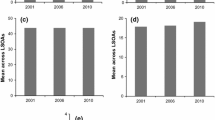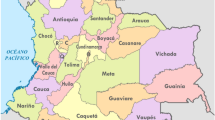Abstract
Within the framework of the National Environmental Health Action Programme of Hungary (NEHAP) (Pinter 1996) a health environmental geographic information system (HEGIS) has been developed in the National Institute of Environmental Health. The aim of this system was to evaluate the association between health and environmental data, in order to track spatial and temporal changes and thus to provide a basis for planning of health risk reduction and intervention programmes (Gordon and Womersley 1997).
Access this chapter
Tax calculation will be finalised at checkout
Purchases are for personal use only
Preview
Unable to display preview. Download preview PDF.
Similar content being viewed by others
References
Alexander, F. E. and Cuzick, J. (1996) Methods for assessment of disease cluster. In: P. Elliott, J.Cuzick, D. English, and R. Stern (eds.) Geographical and Environmental Epidemiology: Methods for Small-Area Studies. Oxford University Press, Oxford, pp. 238-250
Anon (1992) CORINE Land Cover Database. Budapest: FÖMI RSC.
Bernadelli, L, Pascutto, C, Best, N. G., Gilks, W. R. (1997): Disease mapping with errors in covariates. Statistics in Medicine 16 (7), 741-52.
Besag, J., Newell, J. (1991) The detection of cluster in rare diseases. Journal of the Royal Statistical Society, Series A 154, 143-155.
Briggs, D.J. and Elliott, P. (1995) The use of geographical information systems in studies on environment and health. World Health Statistic Quarterly 48 (2), 85-94.
Central Statistical Office (1994) Demográfiai Évkönyv 1993 (Demographical Year Book 1993). Central Statistical Office, Budapest.
Cislaghi,C, Biggeri,A., Braga,M., Lagazio,C. and Marchi, M. (1995) Exploratory tools for disease mapping in geographical epidemiology. Statistics in Medicine 14, 2363-2381.
Cuzick, J. and Edwards, R. (1990) Spatial clustering in inhomogeneous populations (with discussion). Journal of the Royal Statistical Society, Series B. 52, 73-104
Gordon A. and Womersley J.(1997) The use of mapping in public health and planning health services.Journal of Public Health Medicine 19,139-147
Haberman, S.J. (1972) Log-linear fit for contingency tables - Algorithm AS51, Applied Statistics 21, 218-225.
Kramer, M. S. (1988) Clinical Epidemiology and Biostatistics. Spinger-Verlag, Oxford.
Moore D. A. and Carpenter T. E. (1999): Spatial analytical methods and geographic information systems: use in health research and epidemiology. Epidemiological Reviews 21 (2), 143-61.
Nádor, G.,Páldy, A.Pintér, A.and Vincze I. (2000) A mortalitás térbeli eloszlásának statisztikai elemzése. A leíró epidemiológiai módszer korlátai. (Analysis of spatial distribution of mortality. The limits of descriptive epidemiological method). Egészségtudomány 44, 292-311.
Nagarwalla, N. (1996) A scan statistic with a variable window. Statistics in Medicine 15 (7-9), 845-50
Openshaw, S. (1996) Using geographical analysis machine to detect the presence of special clustering and the location of clusters in synthetic data. In. F.E. Alexander and P. Boyle (eds.) Methods for Investigating Localized Clustering of Disease IARC Scientific publications No. 135., Lyon, pp. 68-86.
Openshaw, S., Charlton, M., Croft, A.W. and Birch, J.M. (1988) Investigation of leukaemia clusters by the use of a geographical analysis machine. Lancet 8580, 272-273.
Páldy A.,Pintér A.Vaskövi E.,Bejczi K,Farkas H.,Bittó A.,Török,G.,Sohár J.,Matyasovszky K.,Koppány E.,Radóczy M.and Szeremi M.(1999) Sajószentpéter és Szerencs egészségügyi állapotának összehasonlító vizsgálata. (Comparative study of health state of SajÓszentpéter and Szerencs).Egészségtudomány 43,209-230.
Pintér A.(ed.)(1996) Nemzeti Környezet-egészségügyi Akcióprogram (National Environmental and Health Action Programme). Secretariat of NEHAP, Budapest.
Thrall, S.E. (1999): Geographic information system (GIS) hardware and software. Journal of Public Health Management and Practice 5 (2), 82-90.
Tim, U.S. (1995) The application of GIS in environmental health sciences: opportunities and limitations. Environment Research 71 (2), 75-88.
Turnbull, B. W., Iwans, E.J., Burnett, W. S., Howe, H. L. and Clark, L. C. (1990) Monitoring for cluster of disease : application to leukaemia incidence I upstate New York. American Journal of Epidemiology 132 (Supplement), S136-143.
WHO (2001) WHO Health for All Database, WHO, Copenhagen
Vincze, I. and Nádor, G. (1999) Halálozási adatok elemzése leíró epidemiológiai rendszerben. (Analysis of mortality data using descriptive epidemiological method).Egészségtudomány 43, 265-74.
Vincze, Ì.,Elek,E.and Nádor,G.(1999): Is Iodide a confounding or effect modifying factor of liver Cirrhosis? In:D.J.Briggs,R.M.Stern and T.Tinker, (eds.).Environmental Health for All. Risk Assessment and Risk Communication for National Environmental Health Action Plans.Kluwer Academic Publishers,Dordrecht, pp.77-84
Author information
Authors and Affiliations
Editor information
Editors and Affiliations
Rights and permissions
Copyright information
© 2002 Springer Science+Business Media Dordrecht
About this chapter
Cite this chapter
Nádor, G., Páldy, A., Zsámboki-Bakacs, M., Pintér, A., Vincze, I. (2002). Geographical Aspects of Mortality and Morbidity Data in Hungary: A GIS Analysis. In: Briggs, D.J., Forer, P., Järup, L., Stern, R. (eds) GIS for Emergency Preparedness and Health Risk Reduction. NATO Science Series, vol 11. Springer, Dordrecht. https://doi.org/10.1007/978-94-010-0616-3_17
Download citation
DOI: https://doi.org/10.1007/978-94-010-0616-3_17
Publisher Name: Springer, Dordrecht
Print ISBN: 978-1-4020-0799-6
Online ISBN: 978-94-010-0616-3
eBook Packages: Springer Book Archive




